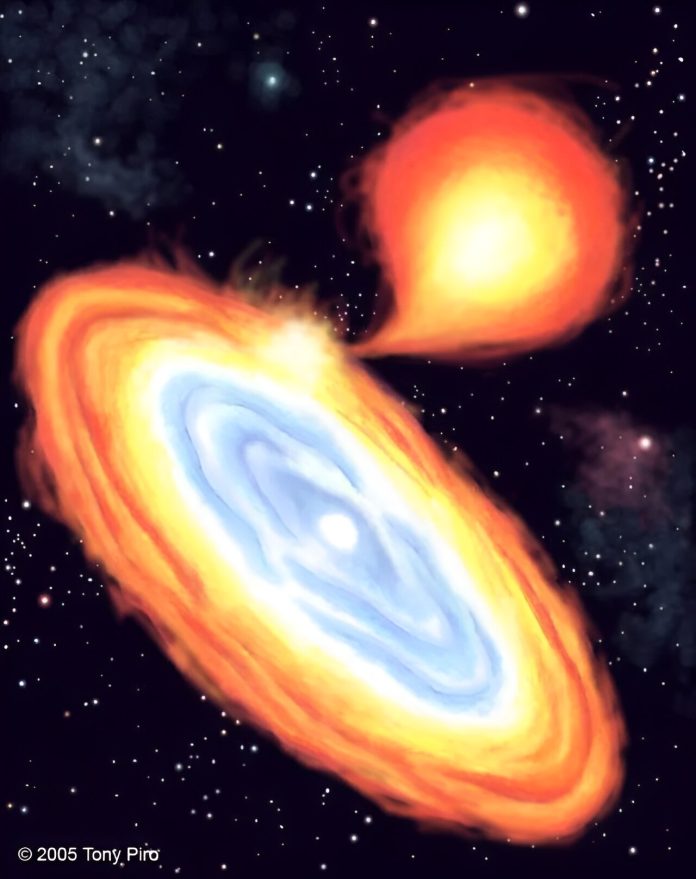
A spectacular celestial event is expected to light up the night sky soon—a stellar explosion that happens only once every 80 years.
We spoke with Tony Piro, a theoretical astrophysicist at Carnegie Science Observatories, to learn more about T Coronae Borealis, the star system at the center of this rare event.
Q: What exactly is T Coronae Borealis, and why is this explosion so special?
Tony Piro: T Coronae Borealis is a binary star system, meaning it has two stars orbiting each other. One star is a white dwarf, which is the dense core left after a star like our Sun burns out its fuel.
The other star is a red giant, which is a large, older star. The white dwarf has a mass about 40% greater than our Sun and orbits the red giant every 227 days.
The red giant is so big that its outer layers are being pulled in by the white dwarf’s gravity. This material forms a disk around the white dwarf, and over time, it builds up on the white dwarf’s surface.
When enough material accumulates, it triggers a thermonuclear explosion, known as a nova, on the surface of the white dwarf. This explosion is incredibly bright and can last for weeks or even months.
Q: When was the last time T Coronae Borealis exploded?
The last nova from T Coronae Borealis was in 1946, and before that, in 1866. Based on this pattern, we expect it to erupt approximately every 80 years, which means we’re due for another explosion soon.
Interestingly, before each of these past explosions, the white dwarf has gone through distinct phases.
About 10 years before the explosion, the star system tends to brighten, likely because the disk is becoming more active and funneling more material onto the white dwarf. We’ve seen T Coronae Borealis brighten again in the last decade, just as it did before the previous explosions.
Also, about a year before each explosion, the white dwarf dims. This dimming started again in March 2023, leading us to believe that the next explosion could happen any time within the next few months.
Q: Why are these recurring novae systems important to astronomers?
There are a few reasons why T Coronae Borealis is particularly interesting. First, it’s the closest of all the recurrent novae, located only about 2,600 light-years away. This proximity allows us to study it in greater detail than other similar systems. Since it erupts relatively frequently, we can also predict when it will happen and prepare for it.
T Coronae Borealis is also intriguing because its white dwarf is close to the maximum mass that a white dwarf can have, known as the Chandrasekhar limit. If a white dwarf exceeds this limit, it can collapse and trigger a much larger explosion called a Type Ia supernova. These supernovae are critical for understanding the universe because they produce many of the heavy elements necessary for life and serve as important tools for measuring cosmic distances.
Additionally, in recent years, we’ve discovered that novae can emit high-energy gamma rays, something we didn’t expect. These emissions are likely caused by shocks created when the exploding material from the white dwarf interacts with the surrounding material from the red giant. Observing T Coronae Borealis will help us learn more about these surprising gamma-ray emissions.
Q: Will people who aren’t professional astronomers be able to see this event?
Absolutely! When T Coronae Borealis explodes, the white dwarf will brighten over about five days, reaching a brightness similar to that of the North Star.
It will be visible to the naked eye for a few hours and then gradually dim over the following weeks. For about five days after the peak, you should still be able to see it with binoculars.
Interestingly, T Coronae Borealis is unique because it brightens again about 100 days after the initial explosion. This second brightening won’t be visible to the naked eye, but astronomers with powerful telescopes will be able to study it in detail.
This is a rare and exciting event that connects us with the awe that astronomers have felt for centuries when observing the wonders of the night sky. While we don’t know the exact timing, it’s sure to be a spectacular sight when it happens.
Source: Carnegie Institution for Science.



